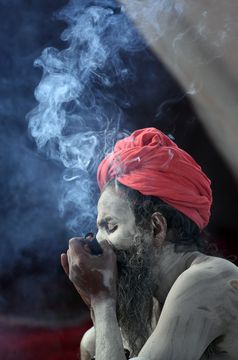The Ganga flows silently. Just a mile away, she will join the gushing Yamuna, who is yearning to meet up with a third river at the Triveni Sangam. It is the third river—the Saraswati—that interests me more. She is a mythical river, born in imagination and with no physical presence. Yet, people believe it is here—at the Sangam—that she exists with the other two holy rivers.
I was a week early at the world’s largest religious gathering. Massive arrangements are in place here. The tent city on the river bed seems endless, the winter fog making the horizon hazier. Spanning over 15km, it houses saints, devotees, officials and workers. For now, the power and water supply is perennial just like the Ganga. The toilets and dustbins are omnipresent, as is the saffron colour, popping up from flags, tents and billboards.
Every naga sadhu’s tent is built with a yagna kund (consecrated fire), which provides warmth in the piercing cold, helps cook food, perform havan (offering to the consecrated fire) and, of course, light the chillum. Entering a sadhu’s tent is a dicey affair. While some pose for the camera willingly, others throw cuss words at you. A few will offer tea and blessings for a price—“Lakdi ke liye kuch de do (give some money for firewood),” says a sadhu’s assistant. Another sadhu, from Avahan Akhara of Haryana, offers devotees halwa that he makes for breakfast. Along with the sweet, he hands out his philosophy on life, world affairs and politics (he is not aligned with any political party, he says). He talks on, taking a break only to puff on his chillum.
The rhythmic inflow of the crowd reaches a crescendo on the day of the first shahi snan (royal bath) on January 15—the day the Kumbh officially begins.
From the Shastri bridge, the roads below look like human rivers, flowing towards the Sangam. The announcements on the loudspeakers dim as the Har Har Gange chants grow louder. The sight and the sounds are both electrifying.
Even as the temperature drops to 8°C, sadhus first take a dip in the Sangam, followed by devotees. Cries of Har Har Mahadev rent the air. The devotees also fill up cans of the holy water to take home. Though the Saraswati remains hidden, the faith of the people is quite striking. The only jarring elements are the cutouts of political leaders, towering over the gathering—a looming reminder of the upcoming Lok Sabha elections.



